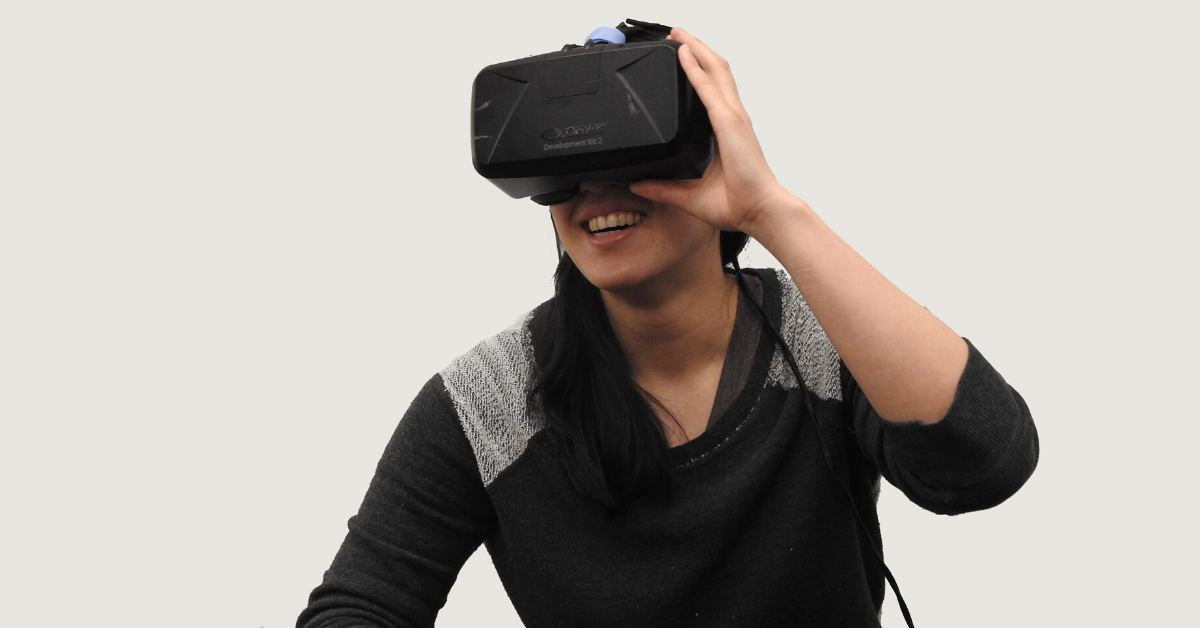Virtual reality is growing every year in the gaming world. Nearly 11% of U.S. adults own some kind of virtual reality (VR) hardware or software according to a study from YouGov. Gaming isn’t the only use for a VR headset though. The real estate industry is a prime example of how virtual and 3D tours can help sell a home faster and easier.
But it’s expensive, right? Well, it can be, but there are lots of options available to agents and home sellers these days. Here are some of the most popular 360 cameras, software, and other tools you’ll want to get to know.
To learn more about the landscape of real estate photography and videography, I spoke to Filip Cvjeticanin from Vidsmart.
Working with a professional real estate photographer and videographer
For many real estate agents, hiring a professional photographer makes the most sense. Depending on the broker you work with, you may already have a contact available to you.
Pros of working with a professional photographer:
- Saves time
- Cost effective
- Flawless end product
Many of these companies that you’ll outsource to will charge a rate per square foot. This drives up the cost for those real estate agents who are new to the industry. As a result, access to a professional with top of the line equipment, like a Matterport camera, is often limited to the top performing agents and luxury listings.
However, some companies, like Vidsmart, charge a flat fee for a range of square footage. For Filip’s clients, this makes the Matterport far more accessible.
“I want to make Matterport available to any sort of agent, and not just luxury agents.” While Filip agreed that larger and higher valued homes are more often spotlighted, many agents he works with use it with home listings as low as $100,000.
If you decide to go the route of creating your own tours, you’ll need:
- A 360 camera and/or a smartphone with 3D capabilities
- A tripod or monopod
- Software to process files
- Hosting services to store and display 3D models and tours
The 360 Cameras
Matterport: The Original Disruptor
For early adopters of virtual tours and 3D modeling, the Matterport was the best and, really, the only option. That’s not the case anymore. What’s most important to note about this and some other options out there, is that the camera is only one cost. You’ll also have to pay a monthly subscription fee for the software that processes or “stitches” the images together and hosting to store and display the tours and models.
Cost of Matterport Pro2: $3,395
Subscriptions for hosting images range from free (for one active model) to $689/month for 250 active models.
The resolution is simply amazing, and many, like Filip, argue worth the price. This is a great choice for professionals who want highly accurate and fast 3D captures of a space. The 134-megapixel 3D camera creates flawless virtual tours of properties of any size, and users can add supplemental information to make the experience even more interactive.
“It’s just a leader in every single aspect of virtual tours. The things that Matterport offers, can’t really be found easily in other companies. Even the things that other companies can offer, they don’t offer all of it. Matterport offers exact measurements of your home. It also offers tags, so people can click on the kitchen counter and read a description of it,” Filip says.
If you’re looking to invest in the camera, the biggest hurdle is likely to be the cost of the camera, the cost of hosting the images, and your lack of control over the images. You may own the camera, but technically, you don’t own the obj file, which is a standard 3D image format that can be exported and opened by various 3D image editing programs. Instead, you’re forced to store with Matterport.
“A lot of agents I work with, they don’t want to do it themselves. Those are the agents that are in like the top 5%,” Filip says, “There are so many agents that are just starting out that don’t want to spend money on a professional photographer.”
If you’re an agent just starting out who can’t afford a professional photographer, the Matterport is most likely not in your price range either. Fortunately, pairing any camera with 360 capabilities (including your phone!) and the right software means anyone can make a 3D tour with an investment as low as a few hundred dollars.
Insta360 ONE X
Cost of Insta360 ONE X: $400
The Insta360 ONE X wasn’t designed with real estate tours in mind. It’s a small but mighty 360 camera with 24-megapixels and a neat trick. The camera removes the stick or tripod it sits on, so it appears to be floating in space.
For those unfamiliar with 360 cameras, it appears that a small drone is capturing the footage. Check out this video to see it in action.
Ricoh Theta Z1
Cost of Theta Z1: $1,000
The Ricoh Theta Z1 has been called the DSLR of 360 cameras. It’s one of the more expensive options of 360 cameras on the market, but the price is reflected in its image quality, which has rich and accurate colors. It produces a raw output similar to a DSLR. Since it’s a point and shoot, you don’t have to worry about aperture or shutter speed.
Shadows and highlights can be corrected easily with some editing software, making it a great choice for interior environments with mixed lighting and perfect for virtual home tours. With 23-megapixel sensors, the sharpness and the ability to shoot bracketed shots makes it one of the best 360 camera of 2019.
Experience the vivid colors and sharpness of the Theta Z1 in this video.
Virtual Tour Software
The more economical camera choices require users to find a compatible software that will convert the images they capture into 3D tours and models.
To compete with these software providers that integrate with more economical cameras, Matterport now has a phone app, Matterport Capture, that you can use with the Insta 360 ONE X, the Ricoh Theta Z1, and other 360 cameras. Currently, the app is only for iOS devices.
Learn how to shoot, edit, create tags, and more with the Theta Z1 or Insta 306 ONE X and Matterport.
CUPIX
The Insta360 ONE X is compatible with CUPIX, the first company to provide software that stitches the images into the 3D models and tours without a specific camera.
The workflows of converting files into the 3D format can be difficult to learn. Fortunately, they have lots of tips on how to use the software with your chosen camera.
Getting started with CUPIX is free, but you’ll have to pay to store more than three 3D tours a month. Upgraded features like measurements, editing studio, and team solutions will also cost more. Compare all their pricing options here.
Check out which 360 cameras are compatible with CUPIX here.
GeoCV
Like the Matterport, GeoCV creates a 3D model of the entire house as you take images throughout the property, but unlike the Matterport, consumers own the copyright of the produced content, so they can white label and self-host the 3D tours. However, there is still a charge for processing the file as the images are captured.
While GeoCV sells a proprietary camera similar to the Matterport, the GeoCV Scanner App is what sets it apart from Matterport as a more affordable option. No camera skill is required and you can use any 360 camera or a phone. In fact, the GeoCV Scanner Kit comes with a pre-calibrated Samsung Galaxy S8 smartphone to use. Unfortunately, you can’t use your own smartphone at the moment.
Zillow 3D Home
More and more cellphones have 3D capabilities like the iPhone 11. Zillow’s 3D Home Tours is a free option designed specifically to work with iOS devices. IPads running iOS 11.3 or later can be used as well, but there’s currently no app for Android devices.
If you’re using your iphone or ipad, you’ll need some additional equipment like a tripod, rotating head, phone mount, and external battery supply for your device.
Both the Ricoh Theta Z1 and Theta V work with the app as well. Scanning a house with one of these devices and Zillow 3D Home should take about 20 minutes.
While images taken from your smartphone won’t be as sharp as one of the 360 cameras mentioned (the iPhone 11 has 12-megapixel sensors compared to the Theta Z1’s 23), and the time to scan usually takes longer (about 30 minutes to an hour), the quality is still pretty good. There are no device or storage fees when you use hand-held capture, and the process is quick and easy.
It’s also probably the option with the smallest learning curve. Real estate agents can quickly upload the tours to Zillow, Trulia, and MLS listings. You might be sacrificing a little bit of quality, but it’s free, quick, easy to use and makes your listings more appealing to buyers or renters.
Rethinking how you measure success
Virtual tours aren’t just a gimmick, and interest in them is likely to grow. According to the 2020 Generational Trends Report from the National Association of Realtors, 42% of all buyers found virtual tours to be very useful.
“I had so many agents tell me that they sold properties using Matterport without people ever coming to see the property because you can get a feel for the property like you are there,” remarked Filip.
He mentioned one listing agent was unhappy with her Matterport experience because less people came to view the house. But this isn’t how you should measure the success of virtual tours. Instead, these tools help you to attract more interested buyers and eventually sell the home faster.
“If people can see the property online and then come see the property [in real life], that’s going to mean they are much more interested in it,” says Filip. To his point, listings that include a Zillow 3D Home tour receive two times as many views than those that don’t. Adding a virtual tour can even help your listing rank higher than others.
Offering this service to your clients will also set you apart from other agents.
“When it comes to branding of an agent, if there is an agent that uses virtual tours on every listing, customers will see that and that will attract them to the agent,” he added.
No matter what option you choose, there is sure to be one that will fit your budget, abilities, and schedule. This technology is changing the way homes are viewed and sold, so now is the time to find the right solution for your business that will delight your clients and homebuyers.









